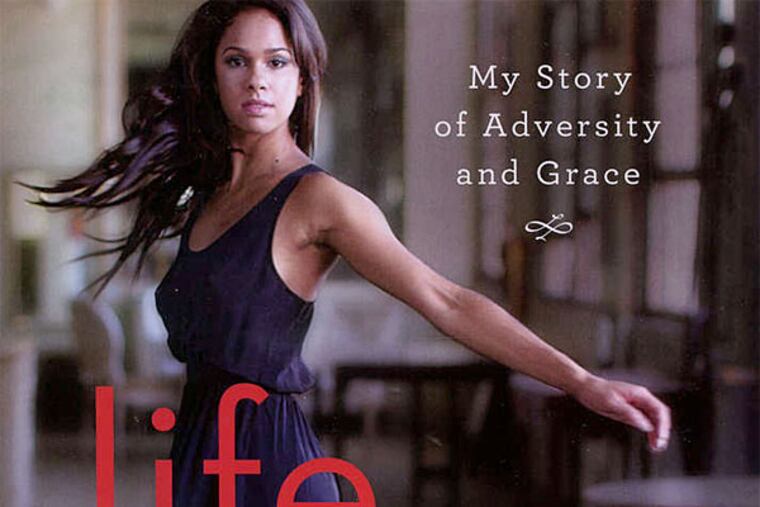An engaging memoir of a dancing life
As a child, Misty Copeland had exactly the right body for ballet: lean torso, long flexible legs, small head, gorgeous feet. She was extremely talented, a quick study, and fearless in class and on stage. She had people who believed in her.

Life in Motion
An Unlikely Ballerina
By Misty Copeland
Touchstone. 278 pp. $24.99
nolead ends nolead begins
Reviewed by Ellen Dunkel
As a child, Misty Copeland had exactly the right body for ballet: lean torso, long flexible legs, small head, gorgeous feet. She was extremely talented, a quick study, and fearless in class and on stage. She had people who believed in her.
Every one of those attributes was necessary to balance what she didn't have: money, a stable home, and ballet lessons almost as soon as she could walk.
But the biggest challenge was that she was African American in an art world teeming with white swans.
"This is for the little brown girls" became her mantra during each of her many successes, including becoming a soloist at the American Ballet Theatre, earning principal roles, going on tour with Prince, and starring in a commercial for Diet Dr. Pepper. But in her engaging memoir, Life in Motion: An Unlikely Ballerina, written with USA Today journalist Charisse Jones, Copeland says she was an unlikely pioneer as well.
Despite growing up in a close-knit family, Copeland had an early life filled with chaos. Her mother moved Copeland and her five siblings in and out of boyfriends' and husbands' mostly comfortable homes. In between, they lived in bare-bones apartments, with friends in dangerous neighborhoods, and for a long stretch in a cramped motel room.
The book is a page-turner that would appeal to people interested in dance, civil rights, and coming-of-age stories. Considering Copeland's often messy early life, it just barely touches on hot-button issues such as alcoholism and violence, making it appropriate reading for all ages.
Life in Motion tells of a shy, nervous girl who came out of her shell when she was performing. Her middle school had a drill team that won many competitions, and her sister Erica had been one of its stars.
"And because the trepidation that dogged every other part of my life seemed to disappear when it came to the thought of performing," Copeland wrote, "I wasn't aiming just to be part of the team: I wanted to be captain."
So she did. It was the team's coach who first saw Copeland as a dancer. Elizabeth Cantine urged her to try a ballet class at the Boys and Girls Club, and it was there that Copeland, wearing baggy gym clothes, first set her hand on a barre. She was 13 - ancient for a novice - but so talented that she started pointe work just eight weeks later, years ahead of schedule.
Soon the ballet teacher, Cindy Bradley, moved Copeland out of the Boys and Girls Club and into her private studio, and out of the cramped motel room Copeland shared with her mother and siblings and in with Bradley, her husband, and young son.
Although living with the teacher brought structure and opportunities, other problems arose. Copeland's mother saw her daughter slipping away from the fold. The last straw was when Bradley produced a lawyer and suggested that teenage Misty petition for emancipation from her mother. That led to a drama that unfolded in a courtroom, ending with Copeland deciding to remain with her mother and both sides giving up the fight, although the drama was later replayed when all the parties appeared on TV's Leeza talk show. The fight didn't derail her ballet career. Copeland stayed with ballet, with her mother's encouragement.
Despite many difficult situations, Copeland never resorts to self-pity in the book. Even after she earned a position at the American Ballet Theatre, one of the most prestigious companies in the world, life was not easy. The corps de ballet, where everyone starts, demands that dancers look alike - and the only African American woman could not help but stand out.
In a gentle way, Life in Motion points out that decades after the civil rights movement, the ballet world is far from integrated.
But Copeland hopes that will change. In September, the American Ballet Theatre, along with Copeland and the Boys and Girls Club, announced Project Plie, to "increase racial and ethnic representation in ballet" and recruit, train, and support young dancers.
The writing of Life in Motion is a little stilted at the beginning, but Copeland's story is so fascinating and emotional that style hardly matters. Still, there are a few odd bits. Seemingly out of nowhere, while still describing the honeymoon period of living with the Bradleys, Copeland mentions holding no resentment toward them, long before we ever find out there was a problem. And Copeland waits until near the end of the book to introduce and quote from the journal she says she kept most of her life.
There are also several unsubstantiated accusations of racism, such as when a prestigious summer program denied Copeland admission while every other audition earned her a scholarship.
Copeland is the second African American ballerina to become a soloist with a major American ballet company. But soloist is the middle of ballet's three ranks. One wonders why she didn't wait to see whether she'd become a principal dancer - to truly break new ground - before writing her memoir.